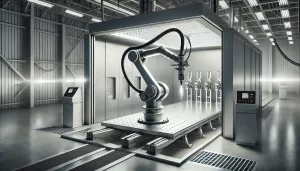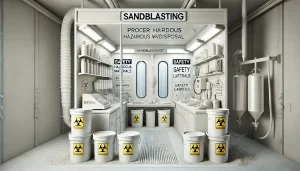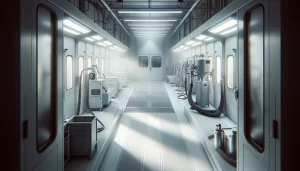When purchasing a paint booth, safety is a priority you can’t afford to overlook. Ensuring that your booth meets essential safety standards protects not only your employees but also your investment. paintbooth.coms are designed to contain fumes, overspray, and flammable materials, all of which can pose risks without proper safeguards. Knowing which safety features to prioritize can make a significant difference in both everyday operations and long-term reliability. Let’s explore the crucial safety features every paint booth should have to ensure a safe and efficient working environment.
Fire Suppression Systems
Fire hazards are inherent in paint booths due to the presence of flammable materials like paint, solvents, and thinners. One of the most important safety features to look for is a fire suppression system. This system is designed to detect and automatically extinguish fires before they spread. Many modern booths come with built-in fire suppression systems, but if not, you’ll want to ensure that your booth can accommodate one.
There are various types of fire suppression systems, but the most common in paint booths are water mist and dry chemical systems. Water mist systems are often preferred because they minimize damage to equipment while effectively quelling flames. On the other hand, dry chemical systems are quick-acting and can be extremely effective in extinguishing fires that occur due to paint overspray. Regardless of the type, the fire suppression system must be able to cover all areas of the booth for complete protection.
Explosion-Proof Lighting
paintbooth.com environments are saturated with fumes and airborne particles, many of which are highly flammable. Normal lighting fixtures are not suitable for this type of atmosphere, as they can create sparks or heat that may ignite fumes, leading to a potential explosion. That’s why explosion-proof lighting is essential for paint booths.
Explosion-proof lights are specially designed to contain any sparks or heat that might otherwise cause a fire or explosion. These fixtures are enclosed to prevent any ignition from spreading outside of the light housing. The result is a safer environment, even when working with highly flammable materials. Always verify that the lighting meets both local regulations and national safety standards.
Proper Ventilation
A well-designed ventilation system is crucial for maintaining air quality in a paint booth. Paint fumes and volatile organic compounds (VOCs) can be harmful to both employees and the environment. Without adequate ventilation, these fumes can build up, increasing the risk of health issues and potentially causing an explosive atmosphere.
Look for a paint booth with an efficient airflow system that draws fresh air in while pushing harmful fumes and overspray out. Cross-draft, down-draft, and side-draft booths all have different ventilation configurations, but the goal is the same: to safely manage air circulation and prevent the accumulation of flammable vapors.
Additionally, the ventilation system should include filters designed to capture paint particles and other contaminants before they can enter the surrounding environment. Proper filter maintenance is also key, as clogged or dirty filters can reduce airflow and create safety hazards. Check that the paint booth includes easily accessible filter replacement options.
Grounding and Electrical Safety
One overlooked but vital aspect of paint booth safety is the electrical setup. Electrical equipment used in a paint booth must be grounded properly to prevent static electricity buildup, which can ignite flammable fumes. Static electricity often builds up when paint and solvents move through the air at high speeds. A sudden discharge can spark a fire or explosion.
Your paint booth should be equipped with grounded electrical components and anti-static measures to reduce these risks. All electrical wiring should be housed in explosion-proof conduits, and any switches or controls should be located outside the booth or in sealed enclosures designed for hazardous environments.
Exhaust Systems and Filters
An effective exhaust system is another cornerstone of paint booth safety. Without it, dangerous fumes and overspray would accumulate, creating a hazardous work environment. The exhaust system is responsible for drawing out the contaminated air, filtering it, and safely releasing it outside the facility.
Make sure the paint booth you choose has an exhaust system that complies with OSHA (Occupational Safety and Health Administration) and NFPA (National Fire Protection Association) guidelines. Also, consider systems that are easy to clean and maintain. Exhaust fans that are clogged with paint particles can drastically reduce airflow efficiency, potentially leading to hazardous conditions.
Emergency Exits and Signage
Though it may seem basic, emergency exits and proper signage are crucial safety elements in a paint booth setup. The booth should have clearly marked exits that employees can access easily in case of a fire or other emergency. It’s also essential that the booth layout and signage direct workers to the nearest exit route in case of smoke or obstruction.
Proper signage goes beyond exits. Warning signs about hazardous chemicals, electrical dangers, and the proper use of personal protective equipment (PPE) should be visible at all times. Signs that indicate areas of restricted access or necessary safety procedures can help reduce the risk of accidents and ensure that workers follow safety protocols.
Personal Protective Equipment (PPE) Compatibility
A safe paint booth setup isn’t just about the booth itself but also the gear workers use. The booth should be designed to support the use of personal protective equipment (PPE), such as respirators, gloves, and protective clothing. For example, many booths include features that allow workers to easily put on and remove respirators or goggles before entering and exiting the area.
Additionally, some paint booths come with integrated air supply systems that work with full-face respirators or hoods, ensuring a steady stream of clean, breathable air. This is especially important in environments with high concentrations of toxic fumes or airborne particles.
Safety Interlocks
Safety interlocks are a critical feature that ensures the paint booth operates safely at all times. These interlocks prevent the booth from functioning unless all safety conditions are met, such as doors being fully closed or the ventilation system operating at the correct level. For instance, if a door is accidentally left ajar, the interlock system will stop the spray operation until it is securely shut.
Interlock systems can also work with fire suppression and ventilation systems to automatically shut off operations in case of a fire, preventing further hazards. When considering a paint booth, check whether these interlock systems are included and what additional safety checks they provide.
How We Can Help with Your Paint Booth Needs
At Paint Booth, we specialize in providing top-tier paint booths and finishing equipment tailored to your business requirements. Whether you need a standard-size paint booth or a custom solution designed for your unique projects, our expert team is here to assist you every step of the way. From design to installation, we ensure that your equipment meets the highest industry standards, enhancing both your productivity and the quality of your finishes. Contact us today to find the perfect paint booth solution for your business!




